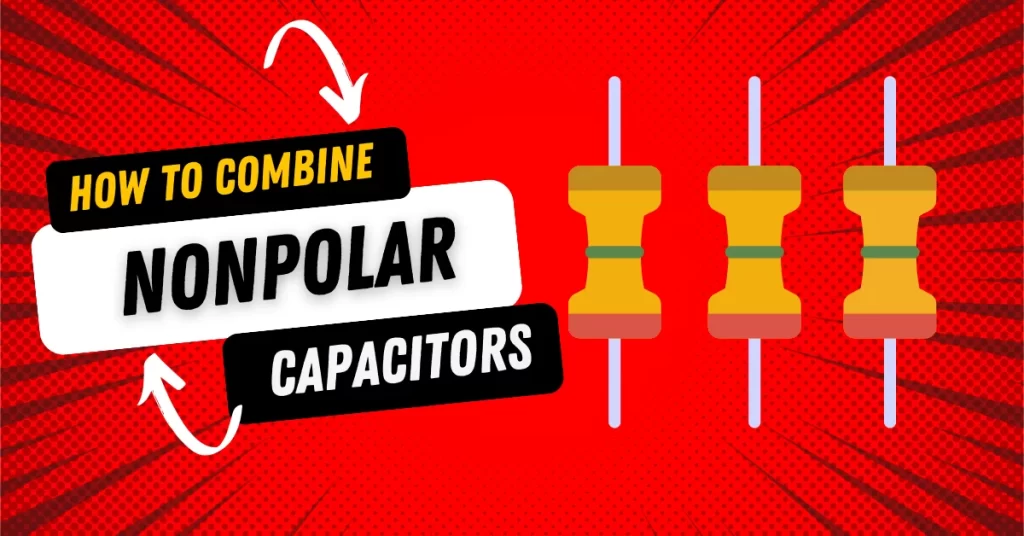Mastering Capacitor Connections: How to Combine Non-Nonpolar Capacitors
In the world of electronics, the art of combining non-nonpolar capacitors can significantly impact circuit performance. Whether you’re a seasoned engineer or an electronics enthusiast, understanding the nuances of capacitor combinations is essential. In this guide, we’ll delve into the intricacies of non-nonpolar capacitors and provide practical insights on how to combine them effectively. Get ready to elevate your electronics game as we explore the science and techniques behind successful capacitor combinations.

Understanding Non-Nonpolar Capacitors: Before we embark on the journey of combining capacitors, let’s first establish a clear understanding of what non-nonpolar capacitors are. These components are fundamental in electronic circuits, and knowing their types and applications is crucial. Non-nonpolar capacitors, unlike their polar counterparts, do not have a specific positive or negative orientation. They come in various forms, including ceramic capacitors, tantalum capacitors, and film capacitors, each with unique properties and characteristics.
Now, let’s proceed with the third heading, “Why Combine Non-Nonpolar Capacitors?”
Why Combine Non-Nonpolar Capacitors?
Combining non-nonpolar capacitors serves several essential purposes in electronics. Here, we’ll explore the primary reasons why engineers and hobbyists opt for capacitor combinations:
- Enhancing Capacitance: One of the key advantages of combining capacitors is the ability to increase the total capacitance in a circuit. This can be especially beneficial when a circuit requires a higher capacitance value than what a single capacitor can provide.
- Voltage Rating Adjustment: Capacitors come with specific voltage ratings. In some cases, combining capacitors in a certain configuration can adjust the overall voltage rating of the combination, ensuring it aligns with the circuit’s requirements.
- Improved Performance: Certain electronic applications demand capacitors with specific frequency response or impedance characteristics. Combining capacitors allows engineers to fine-tune these parameters, resulting in improved circuit performance.
- Space and Size Constraints: Miniaturization is a prevalent trend in electronics. Combining capacitors can help save space while maintaining the required capacitance, making it ideal for compact electronic devices.
Types of Non-Nonpolar Capacitor Combinations:
Now that we understand why combining non-nonpolar capacitors is essential, let’s explore the various methods and configurations for achieving optimal results. Capacitor combinations typically fall into two primary categories: series and parallel connections.
- Series Capacitor Combinations:
- In a series configuration, capacitors are connected end to end. This type of combination is often used when the goal is to increase the total voltage rating while maintaining the same capacitance.
- The total capacitance in a series combination is calculated differently from parallel combinations. It decreases inversely with the sum of the reciprocals of the individual capacitances.
- Engineers choose series combinations when circuits require higher voltage tolerance while keeping capacitance relatively constant.
- Parallel Capacitor Combinations:
- Parallel combinations involve connecting capacitors like terminals. This setup increases the total capacitance while maintaining the voltage rating.
- The total capacitance in a parallel combination is simply the sum of the individual capacitances. This configuration is ideal when the primary goal is to boost capacitance without affecting the voltage rating.
- Parallel combinations are commonly used in applications where high capacitance is required, such as power supply filtering.
Capacitor Selection:
Before diving into capacitor combinations, it’s crucial to select the right capacitors for your specific application. Several factors should guide your selection process:
- Capacitance Value: Determine the required capacitance for your circuit. This value depends on the circuit’s function and the frequency of operation.
- Voltage Rating: Consider the maximum voltage the capacitors will be exposed to in your circuit. Ensure that the selected capacitors have voltage ratings that meet or exceed these requirements.
- Capacitor Type: Different capacitor types have distinct characteristics. Ceramic capacitors are known for their small size, while tantalum capacitors offer high capacitance in a compact package. Film capacitors provide stability and precision.
- Temperature and Environmental Conditions: Evaluate the operating temperature and environmental conditions of your circuit. Some capacitors are better suited for extreme temperatures or harsh environments.
In the subsequent sections of this article, we’ll delve deeper into the practical aspects of combining capacitors in both series and parallel configurations. We’ll provide step-by-step guidance, offer practical tips, and address safety precautions to ensure successful capacitor combinations in your electronic projects.
Series Capacitor Combinations:
Let’s start by exploring series capacitor combinations. This method is commonly used when you need to increase the total voltage rating while maintaining a relatively constant capacitance level. Here’s a step-by-step guide on how to combine non-nonpolar capacitors in series:
- Identify the Capacitors: Begin by selecting the capacitors that match your desired voltage and capacitance requirements. Ensure that they have the same capacitance value but different voltage ratings.
- Connect End to End: Connect the positive terminal of the first capacitor to the negative terminal of the second capacitor. Continue this pattern for all capacitors in the series. This arrangement increases the total voltage rating while keeping the capacitance the same.
- Total Capacitance Calculation: To find the total capacitance of the series combination, use the formula:
1 / (C_total) = 1 / (C1) + 1 / (C2) + 1 / (C3) + ...
Where C_total is the total capacitance, and C1, C2, C3, etc., are the individual capacitance values.
- Voltage Rating: The voltage rating of the series combination is equal to the sum of the individual capacitors’ voltage ratings. Ensure that this total voltage rating exceeds the circuit’s requirements to prevent overvoltage issues.
Parallel Capacitor Combinations:
Parallel capacitor combinations are ideal for increasing total capacitance while maintaining the same voltage rating. Here’s how to combine non-nonpolar capacitors in parallel:
- Select the Capacitors: Choose capacitors with the same capacitance value. This ensures that the total capacitance is simply the sum of the individual capacitances.
- Connect Like Terminals: Connect all the positive terminals of the capacitors and all the negative terminals. This configuration maintains the voltage rating while increasing the total capacitance.
- Total Capacitance Calculation: To find the total capacitance of the parallel combination, simply add up the individual capacitance values:
C_total = C1 + C2 + C3 + ...
Where C_total is the total capacitance, and C1, C2, C3, etc., are the individual capacitance values.
- Voltage Rating: In parallel combinations, the voltage rating remains the same as that of the individual capacitors. Ensure that this rating is sufficient for your circuit’s voltage requirements.
In the following sections of this article, we’ll delve into practical tips for successful capacitor combinations, safety precautions when working with capacitors, and real-life applications of these techniques. Whether you’re looking to optimize circuit performance, save space, or meet specific electronic requirements, mastering capacitor combinations is an invaluable skill. Stay tuned for more insights and guidance on your journey to becoming a capacitor connection expert.
Practical Tips and Considerations:
When it comes to combining non-nonpolar capacitors, practical knowledge can make a significant difference in achieving the desired results. Here are some essential tips and considerations:
- Matching Capacitor Values: Always ensure that the capacitors you’re combining have closely matched capacitance values. Even slight differences can result in imbalanced voltage distribution and performance issues.
- Voltage Ratings: Pay close attention to the voltage ratings of the capacitors. In series combinations, the voltage ratings add up, so choose capacitors with sufficient headroom. In parallel combinations, the voltage rating remains the same as that of the individual capacitors.
- Temperature Stability: Consider the operating temperature of your circuit. Some capacitor types are more stable across a range of temperatures. Tantalum capacitors, for example, offer excellent stability.
- Frequency Response: Depending on your circuit’s application, you may need to consider the frequency response of the capacitors. Ceramic capacitors are known for their high-frequency performance, while film capacitors provide stability in audio applications.
- Size and Space: If space is a concern in your project, take note of the physical size of the capacitors. Ceramic capacitors, for instance, are compact and suitable for miniaturized designs.
Safety Precautions:
Working with capacitors requires careful handling to avoid electrical hazards. Here are some safety precautions to keep in mind:
- Discharge Capacitors: Before handling capacitors, ensure they are fully discharged to prevent electrical shocks. Use a discharge resistor or a specialized discharge tool.
- Correct Polarity: If your capacitors have polarity markings (such as electrolytic capacitors), make sure to connect them in the correct orientation. Reversing polarity can lead to capacitor failure or even explosions.
- Avoid Overvoltage: Be cautious not to exceed the rated voltage of your capacitors, especially in series combinations. Overvoltage can cause capacitors to fail catastrophically.
- Wear Safety Gear: When working with high-voltage capacitors or in potentially hazardous environments, wear appropriate safety gear, including gloves and eye protection.
Real-Life Applications:
Capacitor combinations find applications in various electronic devices and systems. Understanding how to combine non-nonpolar capacitors can be especially valuable in the following scenarios:
- Power Supplies: Many power supply circuits use parallel capacitor combinations to filter out noise and ensure stable voltage output. This results in improved performance and reduced ripple voltage.
- Audio Electronics: In audio amplifiers and signal processing equipment, capacitor combinations are employed to fine-tune frequency response and impedance matching. This helps achieve high-quality audio output.
- Motor Starters: In electric motor circuits, series capacitor combinations can be used for motor starting applications. These combinations help reduce inrush currents and protect motors.
- RF Circuits: Radiofrequency (RF) circuits often utilize capacitor combinations to control impedance and filter unwanted frequencies. This is essential for efficient RF signal transmission.
- Energy Storage: Capacitor banks consisting of series and parallel combinations are used in energy storage systems and electric vehicles to store and release energy efficiently.
Troubleshooting:
Despite your best efforts, issues may arise when working with capacitor combinations. Here are some common problems and solutions:
- Imbalanced Voltage: In series combinations, if one capacitor fails, the voltage across the remaining capacitors becomes unbalanced. Replace the faulty capacitor and ensure all capacitors have matching values.
- Capacitor Leakage: Over time, capacitors can develop leakage currents. Check for physical signs of leakage, and if found, replace the affected capacitors promptly.
- Unexpected Oscillations: In high-frequency circuits, unexpected oscillations may occur due to parasitic elements. Adjust the capacitor values or add damping components to address this issue.
- Excessive Heat: Overheating of capacitors can be a sign of overvoltage or excessive current. Ensure that the voltage and current ratings are within the capacitors’ limits.
Conclusion:
In the intricate world of electronics, understanding how to combine non-nonpolar capacitors is a skill that can unlock a multitude of possibilities. From improving circuit performance and voltage tolerance to enhancing audio quality and energy storage efficiency, the ability to master capacitor combinations is invaluable.
Throughout this guide, we’ve covered the fundamental concepts of non-nonpolar capacitors, the reasons for combining them, and the various methods for doing so. Whether you opt for series combinations to increase voltage ratings or parallel combinations to boost capacitance, you now know how to make informed decisions in your electronic projects.
Remember that capacitor selection is crucial, considering factors like capacitance value, voltage rating, temperature stability, and frequency response. Safety precautions are paramount when working with capacitors, especially in high-voltage applications, so always prioritize your well-being.




